A) demand curves derived from utility functions
B) an individual demand curve estimated from a market demand curve
C) a market demand curve estimated from individual demand curves
D) demand for a resource derived from the demand for the product produced by that resource
E) demand for a product derived from the demand for the resource used to make that product
Correct Answer

verified
Correct Answer
verified
Multiple Choice
A temporary price differential in resource markets is
A) eliminated by resource movements
B) caused by a failure of firms to maximize profits
C) eliminated by resources moving from highlyvalued uses to lowervalued uses
D) caused by Congress increasing the federal minimum wage
E) a result of firms using the MRP = MRC rule in hiring resources
Correct Answer

verified
Correct Answer
verified
Multiple Choice
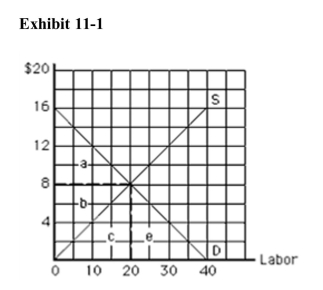 In Exhibit 111, economic rent at equilibrium equals
In Exhibit 111, economic rent at equilibrium equals
A) $40
B) $80
C) $160
D) $16
E) $8
Correct Answer

verified
Correct Answer
verified
Multiple Choice
) 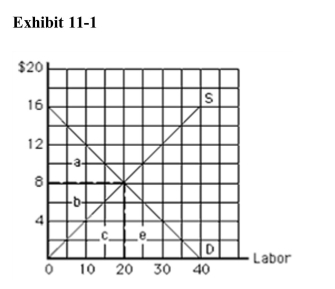 In Exhibit 111, economic rent at equilibrium is represented by area
In Exhibit 111, economic rent at equilibrium is represented by area
A) a
B) b
C) c
D) a + b
E) b + c
Correct Answer

verified
Correct Answer
verified
Multiple Choice
As the price paid to a resource increases,
A) the supply of that resource will increase in the resource market
B) the supply of that resource will decrease in the resource market
C) resources will shift from other resource markets to this one
D) resources will shift from this resource market to others
E) resource usage will be unaffected
Correct Answer

verified
Correct Answer
verified
Multiple Choice
Exhibit 114 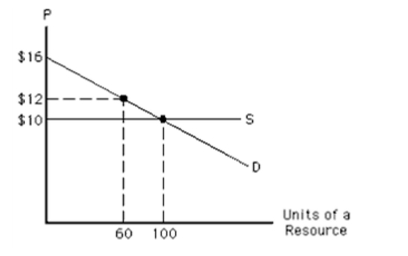 In Exhibit 114, what is the equilibrium price for the resource?
In Exhibit 114, what is the equilibrium price for the resource?
A) $16
B) $12
C) $10
D) less than $10
E) unable to determine from information given
Correct Answer

verified
Correct Answer
verified
Multiple Choice
Suppose that the wage for drivethru clerks is $7 an hour at Burger Kingand $6.50 at McDonald's.The jobs are alike in all other respects.We wouldexpect
A) an increase in the supply of and demand for drive thru clerks at Burger King
B) an increase in the supply and a decrease in the demand for drivethru clerks at Burger King
C) a decrease in the supply of drivethru clerks at Burger King but no change in demand
D) an increase in the supply of drivethru clerks at Burger King but no change in demand
E) a decrease in the supply of and demand for drive thru clerks at Burger King
Correct Answer

verified
Correct Answer
verified
Multiple Choice
A guarded barbed wire fence separates East and West Bovinia.Soccerplayers are paid twice as much in West Bovinia as in East Bovinia.This isan example of
A) inelastic supply
B) a temporary resource price differential
C) a permanent resource price differential
D) diminishing marginal revenue product
E) economic rent
Correct Answer

verified
Correct Answer
verified
Multiple Choice
Suppose that with two froyo machines, 12 workers produce eight quartsof froyo.If the marginal product of the thirteenth worker is two quarts,then
A) thirteen workers produce ten quarts
B) thirteen workers produce two quarts
C) the thirteenth worker alone produces ten quarts
D) the law of diminishing returns cannot be operating in this example
E) diminishing returns must begin with the thirteenth worker
Correct Answer

verified
Correct Answer
verified
Multiple Choice
Both sugar and fructose can be used in the production of candy.If the priceof sugar increases,
A) the demand for sugar increases
B) sugar becomes relatively more expensive than fructose only if the price of fructose falls
C) sugar becomes relatively more expensive than fructose, other things constant
D) the price of fructose immediately increases
E) the price of fructose immediately decreases
Correct Answer

verified
Correct Answer
verified
Multiple Choice
Which of the following is not an example of derived demand?
A) As more high school graduates go on to college, more professors are hired.
B) As consumers buy more computers, they demand more powerful computers as they become available.
C) As people let their hair grow longer, fewer people become barbers.
D) As people buy more tennis shoes instead of sandals, they buy more shoe laces.
E) Increased demand for overnight delivery speeds up orders for new delivery trucks.
Correct Answer

verified
Correct Answer
verified
Multiple Choice
Consider two resource markets in which the demand curves slopedownward.In market A, the supply curve is horizontal, equilibrium price is$6, and 100 units of the resource are hired.In market B, the supply curve isvertical, equilibrium price is $20, and 30 units of the resource are hired.Which of the following is true?
A) All of the resource earnings in market A are opportunity costs.
B) All of the resource earnings in both markets are opportunity costs.
C) All of the resource earnings in market B are opportunity costs.
D) None of the resource earnings in either market is an opportunity cost.
E) None of the resource earnings in either market is economic rent.
Correct Answer

verified
Correct Answer
verified
Multiple Choice
A TV actor used to be a teacher.Aside from the salary, he likes both jobsequally well.If he can earn $50,000 as a teacher and $300,000 as an actor,what are his economic rent and opportunity costs as an actor?
A) Economic rent is $250,000; opportunity costs are $50,000.
B) Economic rent is $50,000; opportunity costs are $250,000.
C) Economic rent is $50,000; opportunity costs are $300,000.
D) Economic rent is $300,000; opportunity costs are $50,000.
E) Economic rent is $300,000; opportunity costs are $350,000.
Correct Answer

verified
Correct Answer
verified
Multiple Choice
Exhibit 112 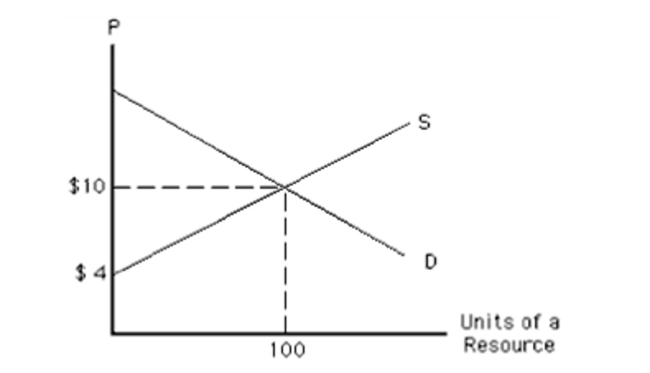 In Exhibit 112, which unit of the resource is earning the most economicrent?
In Exhibit 112, which unit of the resource is earning the most economicrent?
A) the first
B) the tenth
C) the fifteenth
D) the hundredth
E) they are all earning the same economic rent
Correct Answer

verified
Correct Answer
verified
Multiple Choice
Exhibit 112 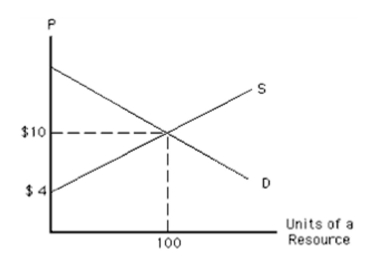 In Exhibit 112, the 100th unit of the resource is earning a resource price of
In Exhibit 112, the 100th unit of the resource is earning a resource price of
A) $10, all of which is economic rent
B) $10, none of which is economic rent
C) $4, all of which is economic rent
D) $4, none of which is economic rent
E) $10, some of which is economic rent
Correct Answer

verified
Correct Answer
verified
Multiple Choice
When resource markets are free to adjust, temporary differentials willcause
A) b, c, and e to occur
B) the allocation of fewer resources to lowerpaid uses
C) the equalization of payments for the same resource in different uses
D) no change in the allocation of resources
E) the allocation of more resources to higherpaid uses
Correct Answer

verified
Correct Answer
verified
Multiple Choice
Exhibit 115  In Exhibit 115, opportunity cost in equilibrium is represented by area
In Exhibit 115, opportunity cost in equilibrium is represented by area
A) 0deh
B) gfeh
C) dcf
D) bed
E) bed + 0deh
Correct Answer

verified
Correct Answer
verified
Multiple Choice
Which of the following is not an example of derived demand?
A) More people want to plant gardens in the spring; therefore, demand for hoes and shovels increases then.
B) Strong ticket sales for a concert cause the producers to schedule an extra show and demand more ushers.
C) Increased use of robots leads to a decrease in demand for labor.
D) The development of alternative fuels made from corn leads to an increase in demand for corn.
E) Increasing demand for music leads to the construction of more recording studios.
Correct Answer

verified
Correct Answer
verified
Multiple Choice
The market demand curve for a resource is the
A) horizontal sum of the demand curves for that resource in all its various uses
B) difference among the demand curves for that resource in all its various uses
C) demand for that resource in its best use
D) sum of the demand curves for that resource in its best two uses
E) vertical sum of the demand curve for that resource in all its various uses
Correct Answer

verified
Correct Answer
verified
Multiple Choice
) 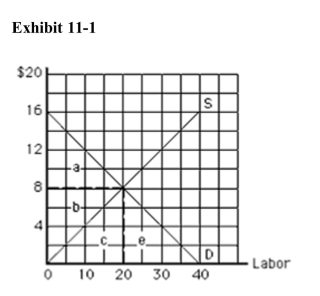 In Exhibit 111, total earnings at equilibrium are represented by area
In Exhibit 111, total earnings at equilibrium are represented by area
A) a
B) b
C) c
D) a + b
E) b + c
Correct Answer

verified
Correct Answer
verified
Showing 41 - 60 of 92
Related Exams